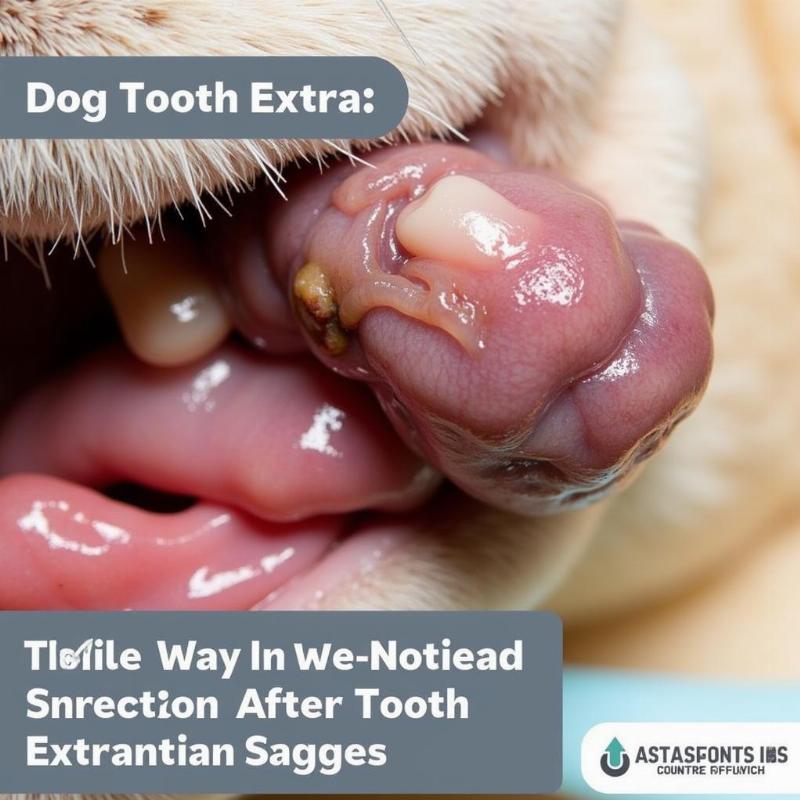Understanding your dog’s tooth extraction recovery time is crucial for their comfort and well-being. This guide provides detailed information on what to expect after your furry friend undergoes this procedure, ensuring a smooth and painless healing process. We’ll cover everything from immediate post-operative care to long-term management, empowering you to support your dog through every stage of recovery.
Factors Influencing Dog Tooth Extraction Recovery Time
Several factors contribute to how long it takes a dog to recover from a tooth extraction. The complexity of the extraction, the size and location of the tooth, your dog’s overall health, and their age all play a role. A simple extraction of a small incisor might heal within a week, whereas a more complex extraction of a molar, especially in an older dog, could take several weeks. Proper post-operative care, as outlined by your veterinarian, significantly impacts the healing process and minimizes potential complications.
Immediate Post-Operative Care
Immediately following the extraction, your veterinarian will provide detailed instructions for at-home care. This usually includes pain medication, antibiotics to prevent infection, and an anti-inflammatory to reduce swelling. It’s crucial to administer these medications precisely as prescribed. Your dog may be groggy and disoriented after the anesthesia wears off. Provide a quiet, comfortable space for them to rest and avoid disturbing them unless necessary.
Dietary Considerations During Recovery
Soft food is essential during the initial recovery period. Avoid dry kibble, hard treats, and toys that could dislodge the blood clot forming at the extraction site. Canned food, softened kibble, or specially formulated recovery diets are excellent choices. Your veterinarian can recommend appropriate food options based on your dog’s individual needs. Ensure fresh water is always available.
Managing Pain and Discomfort
Pain management is critical for a comfortable recovery. Observe your dog for signs of pain, such as whining, excessive licking of the extraction site, decreased appetite, or lethargy. If you notice any of these signs, contact your veterinarian immediately. They may adjust the pain medication or recommend additional strategies to alleviate discomfort. Never administer human pain relievers to your dog, as many are toxic to them.
Signs of Complications
While most dogs recover smoothly, complications can arise. Watch for excessive bleeding, persistent swelling, a foul odor from the mouth, or difficulty eating. If you observe any of these signs, contact your veterinarian immediately. Early intervention is crucial for preventing serious issues.
 Complications After Dog Tooth Extraction
Complications After Dog Tooth Extraction
Long-Term Dental Care
Once your dog has fully recovered, maintaining good oral hygiene is essential to prevent future dental problems. Regular brushing, dental chews, and professional cleanings can significantly improve your dog’s long-term dental health. Your veterinarian can recommend the best dental care routine for your furry companion.
Conclusion
Understanding dog tooth extraction recovery time empowers you to provide the best possible care for your dog. By following your veterinarian’s instructions, monitoring your dog closely, and providing a comfortable and supportive environment, you can ensure a smooth and painless recovery. Remember, Beautdogs.us is here to support you every step of the way.
FAQ
- How long does it take for a dog to recover from a tooth extraction? Recovery typically takes 2-3 weeks, but it can vary depending on the complexity of the extraction and your dog’s individual health.
- What should I feed my dog after a tooth extraction? Soft food, such as canned food or softened kibble, is recommended. Avoid hard food and treats.
- What are the signs of complications after a tooth extraction? Excessive bleeding, persistent swelling, foul odor from the mouth, and difficulty eating are potential signs of complications.
- Can I give my dog human pain relievers? No, never give your dog human pain relievers. Many are toxic to dogs. Consult your veterinarian for appropriate pain management options.
- How can I prevent future dental problems in my dog? Regular brushing, dental chews, and professional cleanings are essential for maintaining good oral hygiene.
- When can my dog eat hard food again after a tooth extraction? Consult your veterinarian, but generally, it’s best to wait at least 2-3 weeks after the extraction site has fully healed.
- What should I do if my dog is still in pain after a tooth extraction? Contact your veterinarian immediately. They may adjust the pain medication or suggest other strategies to alleviate discomfort.
Beautdogs.us is your premier destination for all things dog-related in the US. We offer expert advice on dog breeds, care, and products, catering to both new and experienced dog owners. As a trusted resource, we strive to provide comprehensive and engaging information to help you navigate the joys and challenges of dog ownership. For expert guidance and personalized support, contact us at [email protected] or +1 501-555-7529. Visit Beautdogs.us for more valuable insights and resources!